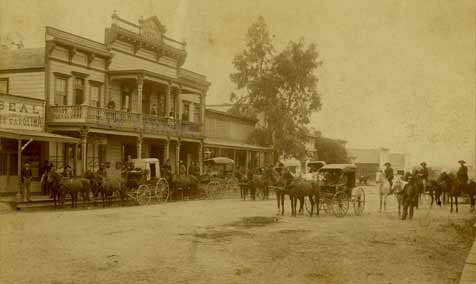Question: ‘What is the history of Los Alamos?’
-Rebecca Crump

Los Alamos is a small town located just off Highway 101 between the Santa Maria and Santa Ynez valleys. It was founded in 1876 by two ranchers, John S. Bell and Dr. James Barron Shaw, who saw, with the arrival of the stagecoach line, a chance to cash in by starting a town. Since its founding, the fortunes of the town have very much been shaped by the development of different transportation systems in the county.
The Los Alamos Valley (alamos is Spanish for cottonwoods) was first home to a Chumash village. This village was abandoned in the early 1800s, as the newly baptized Chumash came under the sway of Mission La Pur-sima. Replacing the village was a new settlement of Chumash who tended the cattle herds of the mission. As elsewhere on the South Coast, the natives suffered greatly from newly introduced diseases against which they had no resistance; a smallpox outbreak in the mid 1840s dealt an especially severe blow. By the mid 1850s, only eight natives were left in the valley.
In 1839, Jose Antonio de la Guerra, a son of Jose de la Guerra, the great ranching grandee of the de la Guerra clan, was granted the Rancho Los Alamos of almost 49,000 acres and received the patent on the ranch from the U.S. government in 1872. To the east sat Rancho La Laguna, more than 48,000 acres in extent, granted to Octavio Gutierrez in 1845, patented in 1867.
In 1868, Bell and Shaw entered the picture. Acting on behalf of San Francisco financier Thomas Bell, Shaw engineered the purchase of 14,000 acres of the Los Alamos ranch for Bell’s son, John, and at the same time bought the same amount of acreage of the La Laguna rancho for himself. This change in ownership was part of a larger pattern, the transfer of economic and political power from the families of Old California to newly arriving Yankee owners, a pattern occurring up and down the state.
The valley may very well have remained a largely undeveloped area but, in 1874, the stagecoach route was shifted to run through it and the stage company erected a stable and dining establishment there. Shaw and Bell began to sell off portions of their ranches to attract settlers and, in 1876, hired surveyors to lay out a town site on the border between their two ranches. The town was a square mile in extent, with individual lots 50 by 200 feet. One of the main streets was christened Centennial, commemorating the nation’s 100th birthday that year.
The first building erected in the new town was a residence/store by one A. Leslie. Soon after, J.D. Snyder, who served as the local Wells Fargo agent, built another store, which he transformed into a hotel. This building burned down in 1893, but was later rebuilt and today is known as the Union Hotel. By 1877, the town also boasted a blacksmith shop, post office, and saloon; a school district was formed that same year. A butcher shop, flour mill, restaurant, and more saloons soon followed.
The next big event in the town’s development occurred in 1882, when the narrow-gauge Pacific Coast Railway arrived, opening up Los Alamos to the coast. Los Alamos now became a major shipping point for the area’s agricultural goods. By the spring of 1883, some 450 people called Los Alamos home.
This was the high point in the town’s early development. In 1887, the railway was extended to Los Olivos, eliminating Los Alamos’s importance as the terminus. The narrow-gauge railroad would not be completely abandoned until the early 1940s, although by then trucking had greatly reduced the importance of rail traffic. When Highway 101 was rerouted in the 1960s, Los Alamos was bypassed, thus further inhibiting the town’s growth. In recent years, this community of some 1,200 people has been more impacted by development. Still, Los Alamos has retained much of its rustic 19th-century flavor and charm.



